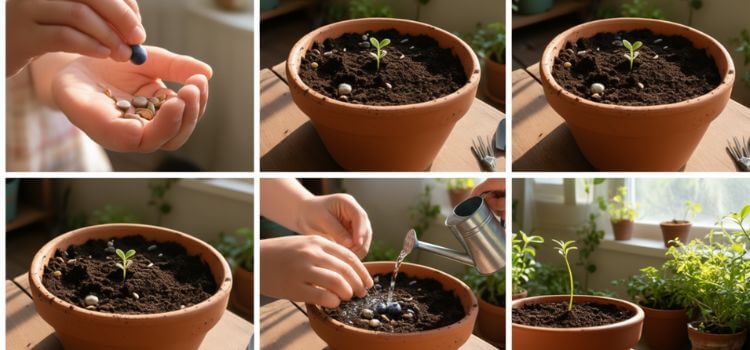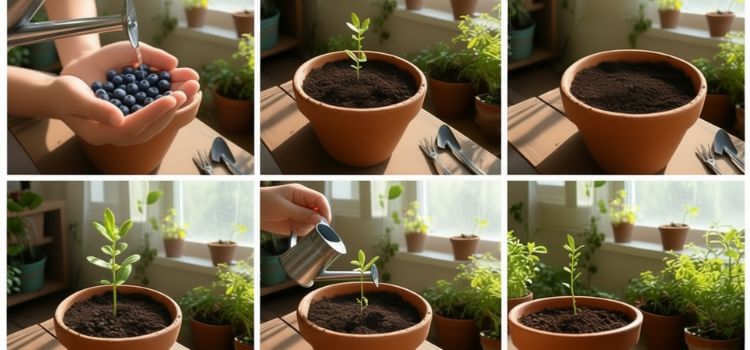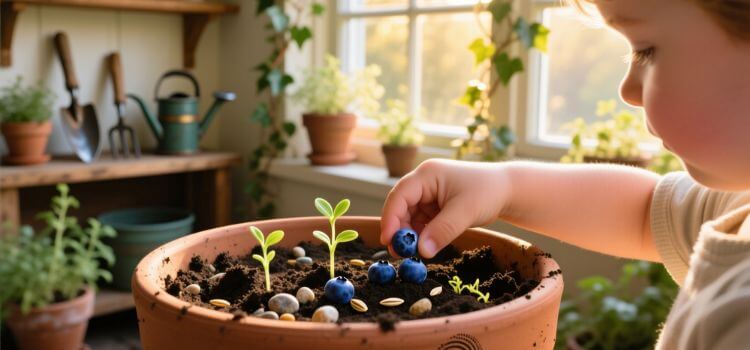As an Amazon Associate, I earn from qualifying purchases.
Have you ever dreamed of growing your own blueberries from scratch? Learning how to grow blueberries from seeds is one of the most rewarding experiences in gardening. It’s like planting little treasures in your garden that can give joy for years. Imagine plucking tiny, sweet berries from your own plants and adding them to breakfast oatmeal or fresh smoothies. Doesn’t that make your day instantly brighter?
Growing blueberries from seeds might seem complicated, but with the proper steps and patience, anyone can do it. I remember the first time I tried it—it felt like holding the future in my hands. Watching a tiny seed sprout into a delicate plant is magical. You feel a deep connection to nature, and every small green shoot brings you hope.
Many gardeners avoid starting from seeds because it takes time and effort. True, blueberries grown from seeds need more care and patience than young plants, but the reward is unmatched. You get the satisfaction of growing your own plant from zero, and you can experiment with different blueberry varieties.
Before we dive into the practical steps, let’s discuss why growing from seeds matters. It saves money, allows customization, and gives you a deep understanding of plant care. Are you ready to turn tiny seeds into a lush, berry-producing plant? Let’s start this journey together!
What Is Growing Blueberries from Seeds?
Growing blueberries from seeds means starting plants from the actual fruit seeds instead of buying seedlings. This method allows gardeners to have more control over the plant and even create new varieties over time.
Why is it important? Seeds are the foundation of plant life. If you start with quality seeds and proper care, your blueberry plants can be strong, healthy, and productive. Starting from seeds also teaches patience, observation, and dedication. I’ve found that gardeners who start with seeds understand their plants better—they notice early signs of stress, growth, or soil issues.

Tip: Always choose seeds from ripe, healthy blueberries for the best chance of success. Using low-quality or unripe seeds can lead to weak or slow-growing plants.
Another advantage is cost. Seeds are cheaper than mature seedlings. Additionally, growing from seeds allows you to experiment with heirloom or rare varieties that may not be readily available in stores.
How Does Growing Blueberries from Seeds Work in Our Real Life?
The process involves several steps: extracting seeds, stratification, planting, and nurturing seedlings until they are strong enough for outdoor planting. Let’s break it down:
- Extract Seeds: Mash fresh blueberries and rinse the pulp under water to collect tiny seeds. Pat them dry gently.
- Stratification: Blueberry seeds need cold treatment to germinate. Place them in a damp paper towel inside a sealed bag in the fridge for 2-4 weeks.
- Planting Seeds: Use small pots or trays filled with acidic potting soil (pH 4.5–5.5). Plant seeds shallowly, about 1/8 inch deep.
- Watering and Light: Keep the soil moist but not waterlogged. Place the trays in bright, indirect sunlight.
- Patience is required, as germination can take 2–6 weeks. Some seeds sprout faster than others, so don’t worry if some take longer.
I tried this in my own garden. After a month, tiny green sprouts began to peek through the soil. Watching them grow every day felt like nurturing a newborn. Patience is key—these little plants need time to develop strong roots before they can be transplanted.
Common Mistakes People Make When Growing Blueberries from Seeds
Many beginners face challenges due to simple mistakes:
- Using neutral or alkaline soil instead of acidic soil
- Overwatering or letting soil dry out completely
- Ignoring stratification, which slows germination
- Planting too deeply, which prevents sprouting
- Not providing enough light after germination
I made the mistake of skipping stratification once. Only a few seeds sprouted, and most didn’t survive. Since then, I always follow the cold treatment step. Proper soil acidity also matters—a pH meter helps.
Spacing is important too. Crowded seedlings compete for light and nutrients. I usually plant 2–3 seedlings per small pot and thin them after sprouting.
How Can You Apply Growing Blueberries from Seeds in Daily Life?
Growing blueberries from seeds has practical benefits:
- You get fresh, homegrown berries for breakfast or desserts
- It teaches children about nature and responsibility
- It saves money compared to buying seedlings or mature plants
- You can experiment with rare or hybrid varieties
Even a balcony or small garden can support a few seedlings. I have a small balcony garden with 5 seed-grown bushes. They give enough berries for family use and look beautiful. It’s a daily pleasure to check their growth and water them carefully.

Step-by-Step Table for Growing Blueberries from Seeds
| Step | Action | Notes |
|---|---|---|
| 1 | Extract seeds | Mash ripe berries, rinse, and dry seeds gently |
| 2 | Stratify seeds | 2–4 weeks in fridge in damp paper towel |
| 3 | Prepare soil | Acidic potting soil, pH 4.5–5.5 |
| 4 | Plant seeds | Shallow planting, 1/8 inch deep |
| 5 | Water & Light | Keep moist, bright indirect sunlight |
| 6 | Monitor | Germination 2–6 weeks, thin seedlings |
| 7 | Transplant | After 2–3 months, move to larger pots or garden beds |
FAQs About Growing Blueberries from Seeds
Q1: How long does it take for seeds to grow into fruit-bearing plants?
Blueberry plants grown from seeds take 2–3 years to produce fruit. Dwarf varieties may produce sooner. Patience is essential.
Q2: Can I skip stratification?
No. Cold treatment is necessary to break seed dormancy. Skipping it results in slower or failed germination.
Q3: What soil is best for seedlings?
Use acidic soil with pH 4.5–5.5. You can mix peat moss, perlite, and sand for good drainage.
Q4: How often should I water seedlings?
Keep soil consistently moist but not soggy. Water gently to avoid washing out seeds.
Q5: Can blueberry seeds be stored?
Yes, dry seeds can be stored in a cool, dark place for several months. Long-term storage may reduce germination rates.
Conclusion
Learning how to grow blueberries from seeds is a rewarding journey. It takes patience, care, and attention, but the results are worth every effort. From extracting seeds to nurturing seedlings, each step teaches a valuable lesson in gardening and life.
Seed-grown bushes develop strong roots and can thrive for years, producing sweet, nutritious berries. Starting from seeds also gives you flexibility to experiment with rare varieties and learn the nuances of plant care.

